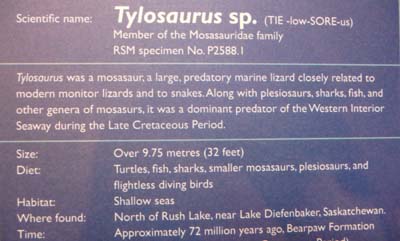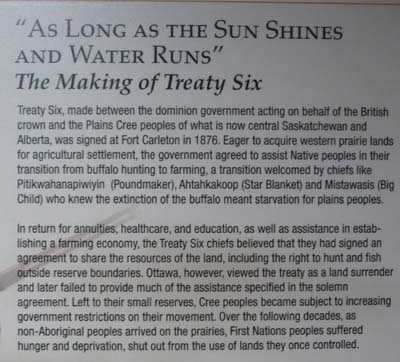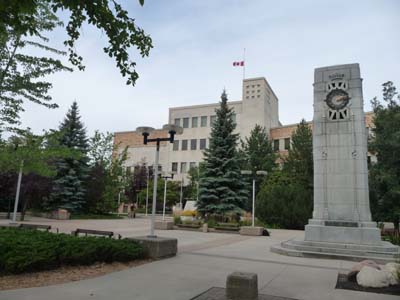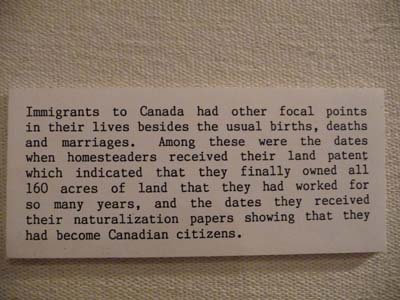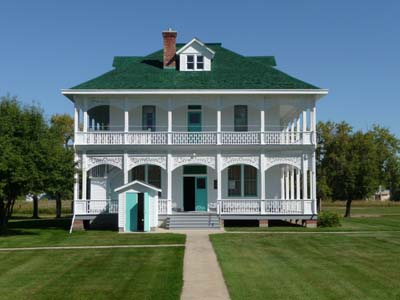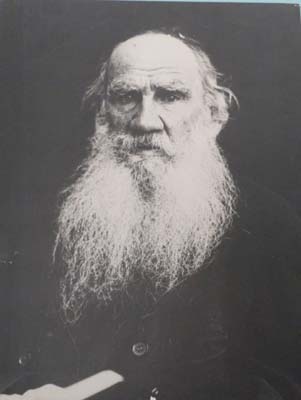-- From Medicine Hat to Yorkton

The road tracklog
from
Medicine Hat to Yorkton
from 2011/08/22 to 2011/08/28
Saskatchewan
The first day in Saskatchewan was devoted to two visits with a jump behind of several million years. Initially I visited Fort Walsh in the Cypress Hills Interprovincial Park. Of course the interest was not the Fort but an Interpretive Centre which in a setting in very didactic scene gives full information on its origin. Its construction was justified by three objectives: Enforcing the law (which entailed stopping the illegal whiskey trade with Indians), implementing Canadian "Indian policy" (which involved encouraging the First Nations to settle onto reserves), and establishing the Canadian sovereignty in the North West Territories. Some panels are very eloquent.
Fort Walsh
|
|
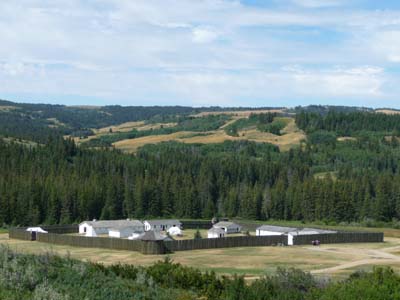
|
|
Then I took the Cypress Gap Road – gravel road in bad state– to go from the west block of the park to the east bloc which is the privileged place of stay of the families in this end canicular season (+30°C). I had there a collation without delay.
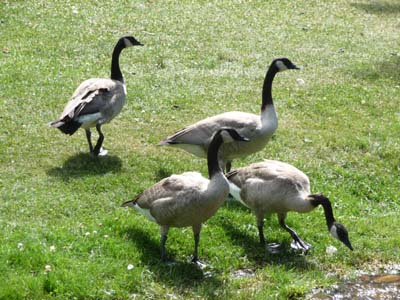
Canada Geese
Cypress Hills Park
22/08/2011
Eastend
To make a shortcut I took another gravel road –Davis Creek Road– to head to Eastend in order to visit T-Rex Discovery Centre. Admittedly still a museum of dinosaurs, but anyone doesn't resemble, all bring a stone to the building of the knowledge of animals of the Cretaceous Period. This one has the most complete T-Rex skeleton in the world and an giant predator Tylosaurus.

|
|
It exhibits three T-Rex skulls and Brontothere. All these fossils and well others were found in the area of the south of Saskatchewan. Before entering Eastend I had warned a boat launch where I spent a cold night at the edge of Frenchman River!
|
|
Tuesday August 23 was still a beautiful day but with some clouds veiling the sun. At Val Marie, gate of Grasslands National Park, I asked for walks to be made in this park without tree. On Ranger's advice I walked a loop of 5 km from the “70 Mile Butte”. They are eroded mountains covered with graminaceous. On the move I met, I though, a marmot which looked at me with caution.
Val Marie, Grasslands
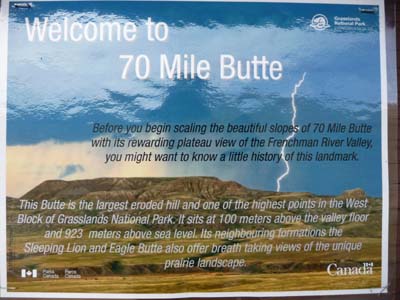
|
|
On the way I admired a mural placed on a barn. On a slope I stopped my truck to take a picture of a chalk outcrop of the Cretaceous Period, two heavy trucks had to stop, the drivers greeted me nicely.
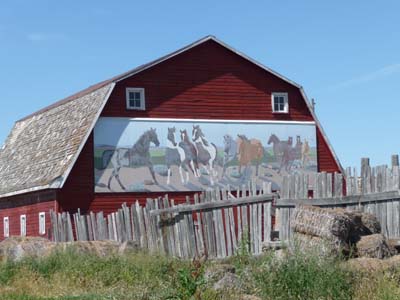
Barn
En route
23/08/2011

Cretaceous limit
En route
23/08/2011
A 18 km detour carried out me in the afternoon to St Victor where Provincial Park protects Petroglyphs whose purpose is unknown and the date possibly former to 1750. They are very damaged by weathering. I bivouacked on the spot.
St Victor

|
|
Before starting from St Victor I attended a sumptuous rising of the sun. The day was announced radiant, it was it with a temperature recorded of 30°C at 5 p.m. Saskatchewan is the hottest province of Canada in summer.
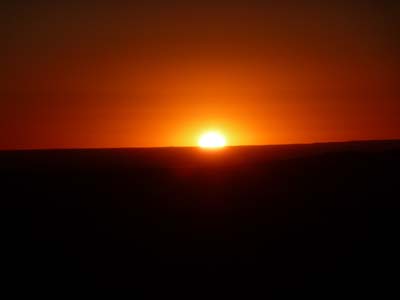
Lever du soleil
St Victor
24/08/2011
Moose Jaw
The town of Moose Jaw is known as “Little Chicago” bus Al Capone took refuge there to make its alcohol trade during prohibition. Close to the station the cellars, Tunnels, buildings were used by the Chinese refugees where it worked, slept and ate under deplorable sanitary arrangements.

|
|
I paid the visit of those occupied by the Chinese, another visit is devoted to those used by Al Capone. Of course Photo No.
|
|
The city is also famous for its murals, it counts some nearly fifty, I visited some close to the station of them. Certain old buildings are of style Art Decoration.
|
|

Regina
In the early afternoon I arrived in Regina, capital of Saskatchewan with about 150,000 inhabitants. Sights are concentrated around Wasca Lake built in 1908. I paid three visits. Royal Saskatchewan Museum which on two floors exhibits the geological, animal & First Nations history. Organization is superb but the exhibits do not bring anymore information compared to the preceding visits.
|
|
Mackenzie Art Gallery exhibits paintings of the local artists and mainly the Group of the Five, two samples by Kenneth Lochhead & by Arthur F. Mckay

|
|
In the late afternoon I walked to explore downtown, nothing to see, only functional buildings. I bivouacked on the carpark of Walmart.
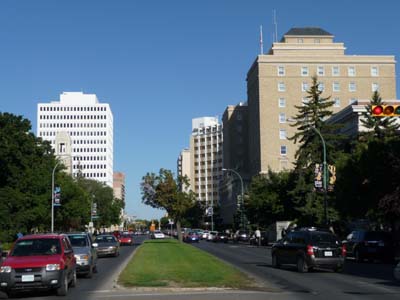
By leaving Regina I made a long detour to see Echo Lake, turquoise gem enchased in mountains. Hwy # 210 twists along the lake but it is impossible to approach it, residences are built on its banks.

Echo Lake
Hwy #210
25/08/2011
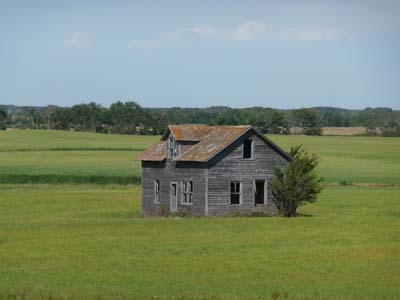
Small house in the prairie
Hwy #35
25/08/2011
The target of the day was to visit Batoche, National historic Site of Canada, where a battle between Métis and the British army proceeded, a very no-glorious page of British colonization, although General Middleton commander of the Field force was rewarded and became keeper of the crown jewels! As with First Nations the government of Ottawa never respected with Métis neither the signed treaties nor the word given. There remains only the church and the presbytery, and of course a cemetery where the protagonists of this battle rest which opposed 800 soldiers strongly armed to 200 Métis equipped with rifles. A image wall with three projectors puts in scene the causes of the conflict and the battle with pictures of this time and a reconstitution. I found an excellent bivouac beside the South Saskatchewan River.


Old village
Batoche
25/08/2011

Cemetery & church
Batoche
25/08/2011

Batoche
25/08/2011

Fort Battleford
Saskatchewan creates in its four main cities, Moose Jaw, North Battleford, Saskatoon and Yorkton, theme museums, Saskatchewan Western Development Museum, around the colonization of the province by Europeans, WASP; I did not visit them preferring to concentrate me on the installation of the forts of the Mounted Police – Mounties– to fix the First Nations and the Métis. This history started in Fort Battleford. As in Fort Walsh an Interpretive Centre, installed in a building of the Fort, held my attention. I present some significant panels. There as in Australia, Tasmania and New Zealand, the Canadian historian did the work of decantation to quote the facts. The duplicity of the government of the Canadian Dominion appears in all its horror. After having cut down all bison to provide the fur trade, the First Nations, without food resource, were forced to sign leonine treaties which were never honored. Famished they revolted and were cut down like bison; then survivors were parked in uncultivated reserves. Admittedly I summarize a little short, but finally reality is intangible.


Fort Battleford
26/08/2011
|
|

|
|
I devoted the afternoon to my truck, tire rotation by the truck of assistance to the truckers, still 10,000 km, distances are big, and its washing after gravel roads. I bivouacked on the carpark of – WDM–

Permutation des roues
North Battleford
26/08/2011
Saskatoon
The Paris of the Prairies
Lonely Planet quotes or invents the name of “The Paris of the Prairies!” It is a city of more than 200,000 inhabitants where I walked. No Baron Haussmann to conceive the plan of urbanization but a geometrician with a grid in his brain, nothing well exciting.

|
|
I visited the museum devoted to the Ukrainian immigration waiting for additional information to that of Fort St John, eh well no. Some panels and especially some trinkets sold at the gift shop. I flee by Hwy # 16 to bivouac on a rest area in margin of the prairie.
|
|
|
|
Veregin
At the bivouac I realized that the village of Veregin concealed interesting information concerning a Russian community. I thus made a long detour to go & see this village created by Doukhobours persecuted by the Czarist. With the help of Tolstoy who gave them the royalties of his Resurrection novel as well as Society of Friends, the Quakers, 7,500 Doukhobours immigrated in Canada in 1899.

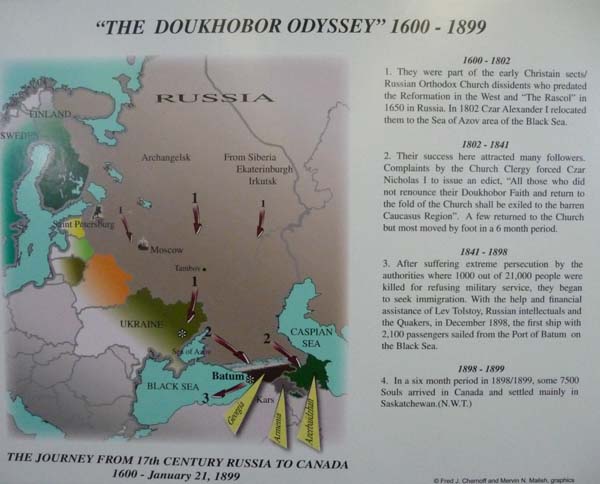
The site listed with the national heritage of Canada is composed of several buildings with furniture of time. The main building, Prayer House, have on the ground floor a room of prayer where I attended the ceremony, and on the first floor apartments.
|
|
Opposite the brick building is devoted to Leo Tolstoy, died in November 1910. I rediscovered his life and his work. I strolled on the lawn from building to building by a pleasant sunny morning.

|
|

Yorkton
The town of Yorkton presents little interest, I spent the night at the City Campground and published my site at McDo.




